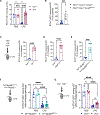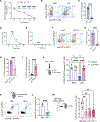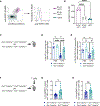TNF-α sculpts a maturation process in vivo by pruning tolerogenic dendritic cells
- PMID: 35417681
- PMCID: PMC9113652
- DOI: 10.1016/j.celrep.2022.110657
TNF-α sculpts a maturation process in vivo by pruning tolerogenic dendritic cells
Abstract
It remains unclear how the pro-immunogenic maturation of conventional dendritic cells (cDCs) abrogates their tolerogenic functions. Here, we report that the loss of tolerogenic functions depends on the rapid death of BTLAhi cDC1s, which, in the steady state, are present in systemic peripheral lymphoid organs and promote tolerance that limits subsequent immune responses. A canonical inducer of maturation, lipopolysaccharide (LPS), initiates a burst of tumor necrosis factor alpha (TNF-α) production and the resultant acute death of BTLAhi cDC1s mediated by tumor necrosis factor receptor 1. The ablation of these individual tolerogenic cDCs is amplified by TNF-α produced by neighboring cells. This loss of tolerogenic cDCs is transient, accentuating the restoration of homeostatic conditions through biological turnover of cDCs in vivo. Therefore, our results reveal that the abrogation of tolerogenic functions during an acute immunogenic maturation depends on an ablation of the tolerogenic cDC population, resulting in a dynamic remodeling of the cDC functional landscape.
Keywords: BTLA; CP: Immunology; LPS; TNF-α; TNFR1; activation; cDC1; death; dendritic cells; maturation; tolerogenic.
Copyright © 2022 The Authors. Published by Elsevier Inc. All rights reserved.
Conflict of interest statement
Declaration of interests The authors declare no competing interests.
Figures






References
-
- Ardouin L, Luche H, Chelbi R, Carpentier S, Shawket A, Montanana Sanchis F, Santa Maria C, Grenot P, Alexandre Y, Gregoire C, et al. (2016). Broad and largely concordant molecular changes characterize tolerogenic and immunogenic dendritic cell maturation in thymus and periphery. Immunity 45, 305–318. - PubMed
Publication types
MeSH terms
Substances
Grants and funding
LinkOut - more resources
Full Text Sources
Molecular Biology Databases
Research Materials
Miscellaneous

